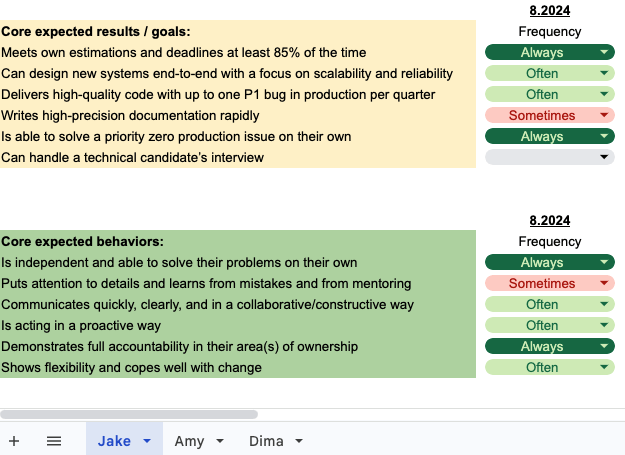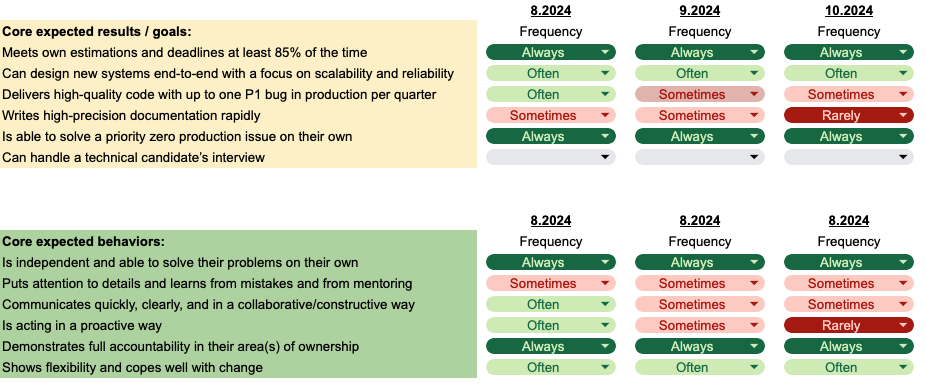You have 1 article left to read this month before you need to register a free LeadDev.com account.
Performance management can be a difficult and uncomfortable path for managers.
As a senior engineering leader, I have needed to prove my engineering team’s high performance many times. Often, it was my manager, the CEO, who asked me to provide clear evidence that the team of 50 was running fast, delivering high-quality code, and satisfied while doing so. In other periods, I was also asking myself those same questions. To provide evidential reasoning, I needed hard data.
Why measure team performance?
Many may ask if it is necessary to audit and measure team performance. And if so, at what stage is it appropriate to do so?
When teams are smaller, around ten engineers, for example, it’s easier to maintain high performance without any measurements or KPIs. But, when teams and engineering organizations start to grow, say to around 50 engineers, a straightforward framework becomes necessary, allowing leaders to track and measure how teams operate across the various areas of ownership they have.
As a consultant for senior engineering leaders (CTOs, VPs of engineering), I often find that first-time founders go through multiple maturity phases in their start-ups. From the founding team of five developers, through to the teams of 20 engineers or more.
Keeping high performance in each and every maturity phase is the most commonly raised challenge by these managers. The reasons behind this are:
- The manager’s lack of past experience in establishing and maintaining high performance.
- The almost impossible challenge of hiring superb engineers and retaining them.
- General pressure coming from above (CEO, the board) to run quickly while delivering high-quality products. This is often coupled with a desire for managers to provide predictability for deliveries.
With that in mind, engineering leaders are seeking ways to evaluate their teams, put them on equal footing, and, ultimately, enhance the overall productivity and performance of their departments.
A performance management framework
To help leaders track team efforts, I formalized an “engineering boost” framework I’ve been using for many years.
At the base of the framework lies a very simple formula:
Team performance = f(results, behaviors)
- f represents “a function of”
- Results are the measurable outcomes produced by the team
- Behaviors are the actions and practices exhibited by team members
In other words, a team member’s performance is a collection of the tangible results and behaviors that lead to these results.
There is no single “score” per team member or team. Instead, we measure the frequency at which core results and behaviors are exhibited.
More like this
Performance management template
Here is an example of how the framework might be used in action. First, as senior engineering managers, defining the five to six core results and behaviors roles should exhibit is essential. Engineering managers can also have their own core results and behaviors, which can be defined and tracked by their direct manager.
Here is an example of these core results for a software engineer, taken from a 25-engineer group in a start-up:

Here are the core behaviors of the same engineer:

The same spreadsheet is used for every team member:

Over a period of time, managers can start seeing trends. Leaders might be able to observe areas where the employee’s performance deteriorated or behavioral areas the employee can get better at:

Providing feedback using the engineering boost framework
The engineering boost framework is a management tool that quickly lets managers see an in-depth overview of their team members, teams, and departments.
However, the framework’s true value lies in its application: using it as a basis for providing targeted feedback.
It is true and widely accepted that not all team members should be super strong and exhibit an all-green performance at all times. Yet it is crucial for managers to provide clear and immediate feedback to their report once they notice deviations from core expectations, restoring performance to its former high levels quickly.
As seen in the above example, Jake isn’t paying attention to detail and is delivering bugs into production every now and then. With time and the absence of feedback, his performance might get worse.
But what if Shila, the engineering manager, sets up a 1:1 to provide him with clear and constructive feedback in an empathetic manner? She could broach that she’s noticed the attention to detail fading on some of his tasks, which has caused some quality issues. She would then add that she would like to help him get better at this, creating positive engagement.
In this scenario, she does not give up on him as a report but also does not give in to him regarding her expectations.
Handling resistance during feedback talks
Leaders need to be prepared for resistance so that they can handle it skilfully and ensure the framework’s effectiveness. Remember, the goal is to use the engineering boost framework to drive improvement and not to create conflict.
Here are four elements to consider while dealing with resistance in feedback talks:
- Be sensitive and listen → Let your report speak
- Show empathy → Say, “I understand what you are saying.”
- Ensure consistency → Keep the expectations and propose your help
- Focus on growth → Frame feedback as an opportunity for improvement rather than criticism
Here’s a final feedback talk simulation:
“I understand your concerns, but my expectation is still that you collaborate with your team members.
We can discuss how to improve this together. For example, we can have a few 1:1 meetings during the next project with team members from other groups. This is an important part of your growth as becoming a senior developer involves working with multiple interfaces.”
This feedback isn’t universal, but the engineering boost framework has plenty of scope to unlock higher performance in other areas, such as communication skills, KPIs, growth plans, and more.
Final thoughts
As senior engineering leaders, it is our obligation to measure our team’s performance but also to drive continuous improvement.
Once you grasp the theory behind the engineering boost framework, you can start implementing it in real life. A helpful tip: begin with just one group, such as your engineering managers or a specific team, to ease the implementation process. See how it works for a period of one to three months, focusing on consistent feedback and high standards throughout. Once you’ve honed the process, proceed to expand it throughout your entire department.





